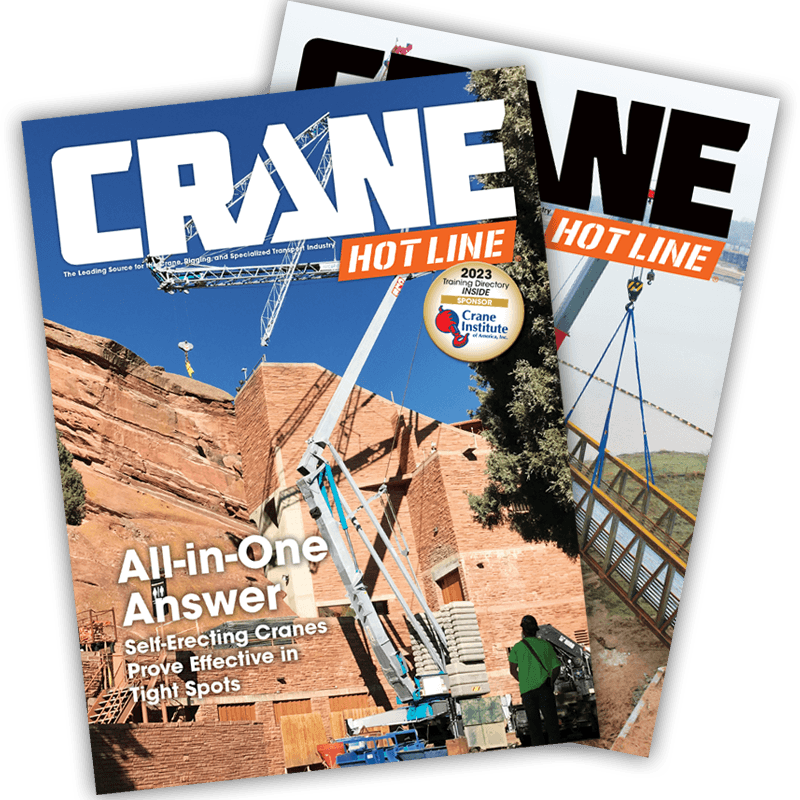The Forecast is Sunny for Gulf Coast Construction
|
|
|
Enlarge Image Creative Lifting Services, formerly Webb Crane, of Denver, uses Benazzato self-erecting cranes for repairing roofs damaged in last year's hurricanes along the Gulf Coast. |
“Regardless of hurricanes, people will always flock to warm climates and beaches, so we see no real slowdown in construction activity in the region,” says Larry Freckman, general manager of ALL Crane Rental of Georgia. In fact, he adds, heavy industry is booming east of

Go west, young man
On the western
And that means higher demand for cranes of all kinds. But if you ask the folks at Lewis Equipment of Prairieland,
“From
Tower cranes are in high demand in these areas, says Russell, because of the lofty path development is taking: “Space is at a premium, so developers are building up instead of expanding outward.”

Hurricane reconstruction progress is as diverse as the areas the storms damaged when they rained down on the
“The story is different in the three states,” says Ken Simonson, chief economist for the Associated General Contractors, Inc. “
And, though the tourism and infrastructure sectors look the healthiest in the
Simonson, who got a firsthand look at the city by small plane and car this summer, says there's great diversity among the areas that have been brought back to life. “In some ways it's impressive • the levees and infrastructure for the
“There is progress on those fronts, but in the large residential areas almost nothing has been touched,” Simonson reports. That means thousands of houses still need to be demolished, just as many immobile vehicles wait to be towed from underneath elevated freeways, and underground utilities demand overhauling because of breakage and corrosion from salt in the water that flowed into the city. “A huge amount of work is required even before those areas can be rebuilt.”
If you're into demolition, there's plenty of work to keep you busy along the hurricane-stricken
FEMA is widely criticized for slow payment and refusal to pay for work, says Simonson. But FEMA isn't the only group on the no-pay list.
“Natural disasters bring out everything good and bad in people,” says Camile Landry of Deep South Crane & Rigging in
As a result, Landry says, his company is sticking to what it knows best: the petrochemical industry. “We're anxious to serve our good customers and the people in that industry and not anything else.” One other thing his company learned the hard way: “If there were another hurricane tomorrow, I would not send a crane out afterward.”

Building with a southern exposure
However, many believe solid reconstruction plans are in the works, and once they gel, there will be lots of work for crane owners. While the housing construction market is experiencing a slowdown in places like
More affordable housing is planned, Jones says, to lure evacuees back to the city. In July the U.S. Department of Housing and Urban Development announced it would pay more than $5 billion into a program to help residents rebuild or sell houses.
To compensate for the area's hurricane-prone climate, says Larry Freckman, General Manager of ALL Crane Rental of Georgia, architects are replacing wood structures with concrete and steel, “which is good news for crane companies.” Plus, he says, new buildings are being designed with parking on the first two levels to minimize loss to homes and businesses.
According to a July article in New Orleans CityBusiness, one company proposes to start a steel plant for housing and business construction in the city. L&L Steel Builders Inc. of
“
Last Spring, Toni Wendel of the local HBA huddled with members of the Steel Framing Alliance to talk about how steel could be used in area residential rebuilding. Alliance President Larry Williams says steel framing is resistant to mold, mildew, warping, fire and insect damage, and can withstand speeds up to 200 mph, according to the CityBusiness article.
The

Growing the rank and file
More critical than labor costs, though, along the hurricane-damaged areas of the
AGC's Simonson reports worries that
And immediately after the storms, many unaffected workers left good jobs they had to help with the reconstruction efforts. “Katrina created a lot of activity and turmoil in the labor ranks in that a lot of people (thought they) could leave what they were doing and go make decent money working for FEMA,” says Landry of Deep South Crane & Rigging.
The Business Roundtable, an association of 160 CEOs of leading
Working with local businesses, construction trade groups, labor unions, community organizations, academic institutions and federal, state and local government to reach their goal, Roundtable companies are committing $5 million for early funding to assist in recruiting participants. Funds from the U.S. Department of Labor's Pathways to Construction program and national emergency grants will be used to implement the training.
“This partnership between government and business will be a powerful catalyst for recovery in the Gulf region, retention and development of the local population, and a model for future disaster recovery,” said Riley Bechtel, chairman and CEO of the Bechtel Group, Inc., who serves as co-chairman of the Initiative.



